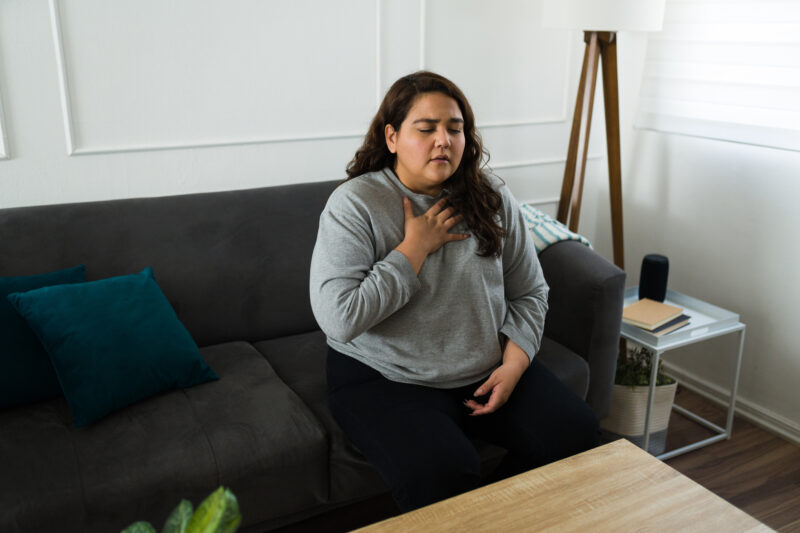
Table of Contents
How to Help Someone Having a Panic Attack, According to Therapists

Written By: Sarah Fielding

Clinically Reviewed By: Bree Williams
July 21, 2025
7 min.
5 tips for how to help someone having a panic attack.
Learn more about our Clinical Review Process
Table of Contents
Panic attacks are a mentally and physically challenging experience. They can cause intrusive thoughts about impending doom or a stressful situation and even uncomfortable physical symptoms, such as an elevated heart rate or difficulty breathing. “A panic attack can be a distressing experience, often mistaken for a medical emergency like a heart attack,” says Charlie Health Contemplative Practitioner Tairesha “Sunflower” Flemister, LMSW.
Support can be critical for a person experiencing a panic attack. There are things you can do as the person having one (and we’ll detail them later on), but there’s so much an outside person can do — especially because in the midst of a panic attack, it’s easy to feel completely alone. So, have you ever wondered how to help someone having a panic attack? Read on to learn more about the signs of a panic attack and what techniques can help a person cope with it.

Help your loved one find the care they need
Virtual, intensive support to manage serious mental health concerns, including panic attacks.
First: What causes panic attacks?
The first step is learning about what a panic attack looks like and what causes them. According to Charlie Health Group Facilitator Bree Williams, LPCA, panic attacks might stem from mental health disorders, including:
- Panic disorder
- Generalized anxiety disorder (GAD)
- Post-traumatic stress disorder (PTSD)
- Social anxiety disorder
- Phobias
However, panic attacks can stem from sources beyond mental health disorders. According to Flemister, other causes of panic attacks include:
- Acute or chronic stress
- Major life transitions or trauma
- Substance use, such as caffeine or stimulants
- Withdrawal from substances
- Medical conditions such as thyroid issues or cardiac arrhythmias
- Genetic predisposition and family history of anxiety disorders
What does a panic attack look like?
Then there’s identifying a panic attack. The person might not be aware that what they’re experiencing is a panic attack or might not be able to convey it. Educating yourself on the signs can be critical to their well-being. According to Williams, panic attack symptoms include:
- Rapid heartbeat or palpitations
- Shortness of breath or feeling like you can’t breathe
- Chest pain or tightness
- Sweating, trembling, or chills
- Dizziness or lightheadedness
- Nausea or stomach discomfort
- Numbness or tingling sensations
- A feeling of losing control, detachment from reality, or fear of dying
However, a person experiencing a panic attack won’t always exhibit all of these symptoms. It’s natural to feel unsure of what to do in the moment, but there are simple ways to support someone effectively — read on for more.
How to help someone having a panic attack
You can be a massive support to someone experiencing a panic attack. There is a range of things you can do and coping mechanisms you can talk through. You can encourage them to try these techniques, but you shouldn’t try to force them. Trying to control their response and decisions could exacerbate the panic attack.
1. Stay calm
It’s crucial that you remain as calm as possible when someone is experiencing a panic attack. The other person will obviously be distressed, and they don’t need more stress added to the equation. Williams and Flemister note that this includes keeping a calm tone of voice.
2. Validate them
Of course, being calm doesn’t mean treating their panic attack as if it were nothing. This is the time to validate their experience and provide reassurance that they are safe with you. Try to avoid saying things like ‘calm down,’ ‘it’s all in your head,’ or ‘it’ll be over soon’ because it can come across as dismissive,” says Charlie Health Licensed Creative Arts Therapist Courtney Way, MA, LCAT.
Instead, Williams recommends saying something like, “I’m here with you. I know this feels really scary, but you’re safe.”
3. Help them regulate their breathing
It’s common for someone experiencing a panic attack to feel shortness of breath or like they can’t breathe at all. Try to help the person return to a regular breathing pattern, says Williams. You can do this through a breathing exercise, such as inhaling for four and exhaling for six, making them aware of their breath. It can also help to try box breathing, in which you follow the pattern of inhaling for four seconds, holding for four seconds, exhaling for four seconds, and then holding again for four seconds. You can breathe alongside them as a sign of support and to normalize it.
4. Show them grounding practices
Similarly, guiding them through various grounding techniques can be highly beneficial to their well-being. Our experts all recommended the 5-4-3-2-1 method. This tool has you ask them to name five things they can see, four things they can touch, three things they can hear, two things they can smell, and one thing they can taste. “This sensory focus can bring their mind back to the present,” says Williams.
You can also encourage them to place their feet flat on the floor or notice the texture of something, like their shirt.
5. Give them space
As Way puts it, “As a general rule, stay with the person if they are comfortable with that.” But remember that each person is different, and they might need some space. They might want the room to themselves or just want some physical distance between you two, while still being able to see you.
On that note, never touch someone who is having a panic attack without asking first. “Even a comforting touch can feel overwhelming during a panic attack,” says Williams. Later, if they’re open to it, you might gently ask how best to support them in future moments like this.
How to help someone after a panic attack
You can also provide critical support to someone immediately and long after they experience a panic attack.
1. Understand they might not want to talk
You can ask if they want to discuss what just happened, but be prepared for them to say no, possibly, says Flemister. Show you’re there for them, but don’t ask them question after question — that goes for during the panic attack as well.
2. Find them a quiet space
Panic attacks are overwhelming and exhausting. When possible, help the other person find a quiet space where they can recuperate. You can also bring them water or a snack, if they want one. The key is to support them in restoring a sense of calm, our experts say.

3. Help them find care
If a person is experiencing regular panic attacks, then they might want to work with a mental health professional. “Therapy can help uncover underlying causes and teach long-term strategies for managing panic symptoms,” says Williams. You can help them find accessible therapy providers — a task that might feel overwhelming for the individual.
“Panic attacks are incredibly distressing — but they’re also manageable,” adds Williams. “Whether you’re supporting someone through it or experiencing one yourself, compassion, calm, and clear tools can go a long way. The more we talk openly about panic and anxiety, the more empowered we become to cope and heal.”
How to help yourself during a panic attack
Panic attacks don’t exactly happen when it’s convenient. There might be times when you experience a panic attack without anyone around. Some of the above coping mechanisms, like deep breathing and grounding, are available to you if you’re on your own during a panic attack.
There are also a few other things to try if you have a panic attack while alone. “When you’re in the midst of a panic attack, it can be difficult to think clearly. Use simple, body-based tools to regain a sense of control,” says Flemister. Here are some options for when you’re having a panic attack.
1. Acknowledge it
Being aware that you’re experiencing a panic attack can position you to deal with it as quickly as possible. It also gives you the chance to summon helpful reminders. “You are not dying: Remind yourself that while it feels scary, this will pass. Panic attacks are not physically harmful,” says Williams. You can also use a mantra like “I am safe” or “This will pass.”
2. Move around
If you’re up for it, Flemister suggests trying to stretch or walk slowly to shift your energy and feel more aware of your body. Way says that even sitting or lying on the ground while making some movements can help.
3. Try mindfulness techniques
You might benefit from mindful options, such as counting backward from 100 or stating different things you notice about the room aloud, says Flemister.
4. Call someone
Just because you’re alone when a panic attack starts, it doesn’t mean you need to stay that way. You can call or text a trusted loved one to share what you’re experiencing or even just to feel connected, says Williams. You can also ask someone to come meet you if there’s a person close enough to reach you. The people in your life want to support and care for you — reach out to them when you need their help.

How Charlie Health can help
If you or a loved one is struggling with your mental health, Charlie Health can help. Our virtual Intensive Outpatient Program (IOP) offers more than once-weekly mental health treatment for people dealing with serious mental health conditions.
Our compassionate, certified mental health professionals can talk you through the mental and physical symptoms of panic attacks. They can also discuss potential causes and coping mechanisms. With this kind of support, healing is possible. Fill out the form below or give us a call to start your healing journey today.




